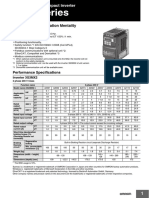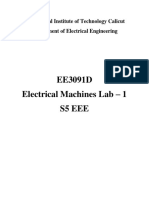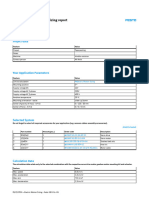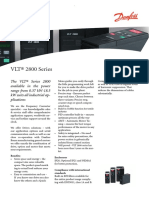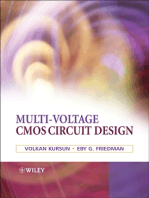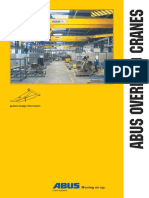Fer 52 01 037 2006
Fer 52 01 037 2006
Uploaded by
Danielle SasongkoCopyright:
Available Formats
Fer 52 01 037 2006
Fer 52 01 037 2006
Uploaded by
Danielle SasongkoOriginal Title
Copyright
Available Formats
Share this document
Did you find this document useful?
Is this content inappropriate?
Copyright:
Available Formats
Fer 52 01 037 2006
Fer 52 01 037 2006
Uploaded by
Danielle SasongkoCopyright:
Available Formats
FALDIC-W Series Servo Systems
Akihiro Itou
Kayo Tsuzaki
Atsushi Narita
1. Introduction setup and maintenance work.
Specifications and features of this new servo
The range of applications for servo systems has system are described below.
recently been expanding to include the field of general
industrial machinery, such as conveyance machinery, 2. Basic Specifications
printing machinery, textile machinery, injection mold-
ing machinery, and to the field of semiconductor Figure 1 shows external appearance of W series.
manufacturing equipment, to achieve better mechani- W series consists of three model types: a low
cal performance and thereby improve productivity in inertia model having 3,000 r / min rated speed, and two
these fields. In addition to the prior requirements for middle inertia models having 2,000 r/ min and
high performance and high precision, availability for 1,500 r /min rated speeds. Basic specifications of these
severe operating environments and easy setup and
maintenance are also required. Fig.1 Appearance of FALDIC-W series
Responding to these marketplace requests, Fuji
Electric has newly developed FALDIC-W series (here-
after referred to as “W series”), as a continuation of its
FALDIC-α series and FALDIC-β series high-perfor-
mance servo systems. W series servo system is
equipped with vibration suppression control to improve
performance and precision, and International Protec-
tion Code IP67 motor to support use in severe operat-
ing environments. Moreover, easy-tuning function and
centralized parameter management function are pro-
vided to increase user’s easy-of-use and to simplify
Table 1 Servomotor specifications
Model GYS□□□DC2-T2△ GYG□□□CC2-T2△ GYG□□□BC2-T2△
Item 500 101 201 401 751 501 751 102 152 202 501 851 132
Rated output (kW) 0.05 0.1 0.2 0.4 0.75 0.5 0.75 1.0 1.5 2.0 0.5 0.85 1.3
Rated torque (N·m) 0.159 0.318 0.637 1.27 2.39 2.39 3.58 4.77 7.16 9.55 3.18 5.41 8.28
Max. torque (N·m) 0.478 0.955 1.91 3.82 7.17 7.2 10.7 14.3 21.5 28.6 9.50 16.2 24.8
Rated speed (r/min) 3,000 2,000 1,500
Max. speed (r/min) 5,000 3,000
Moment of inertia
-4 2 0.0192 0.0371 0.135 0.246 0.853 7.96 11.55 15.14 22.33 29.51 11.55 15.15 22.33
×10 (kg·m )
Rated current (A) 0.85 0.85 1.5 2.7 4.8 3.5 5.2 6.4 10.0 12.3 4.7 7.3 11.5
Max. current (A) 2.55 2.55 4.5 8.1 14.4 10.5 15.6 19.2 30.0 36.9 14.1 21.9 34.5
Altitude at location
Indoor: 1,000 m or less
of installation
Ambient temperature,
-10 to +40°C, 90 % RH or less (no condensation)
humidity
2
Resistance to vibration (m /s ) 49 24.5
Mass (kg) 0.45 0.55 1.2 1.8 3.4 5.3 6.4 7.5 9.8 12.0 6.4 7.5 9.8
FALDIC-W Series Servo Systems 37
Table 2 Servo amplifier specifications
Model RYC□□□D3-VVT2 RYC□□□C3-VVT2 RYC□□□B3-VVT2
Item 500 101 201 401 751 501 751 102 152 202 501 851 132
Applicable motor rated speed
3,000 2,000 1,500
(r/min)
Applicable motor output (kW) 0.05 0.1 0.2 0.4 0.75 0.5 0.75 1.0 1.5 2.0 0.5 0.85 1.3
Single phase, Single phase,
No. of phases Single phase 3-phase 3-phase
3-phase 3-phase
Main 200 to 230 V AC -10 to +10 % (single phase)
power Voltage
200 to 230 V AC -15 to +10 % (3-phase)
Input
Frequency 50/60 Hz
No. of phases Single phase
Control
Voltage 200 to 230 V AC -10 to +10 %
power
Frequency 50/60 Hz
Control method IGBT PWM sine wave operation
Output
Carrier frequency 10 kHz
Overload capability 300 % / 3 s
Control method Regenerative braking applied to intermediate DC circuitry, regenerative resistor installed externally
Feedback Incremental 17-bit encoder (17-bit resolution per revolution)
Control function
Control function Position control, speed control, torque control
Max. frequency of input 1.0MHz (differential input), 200 kHz (open collector)
pulse string
Frequency response 600 Hz (at JL = JM)
17
Position analysis function 2 (= 131,072) / revolution
To be installed indoors, an altitude of 1,000 m or less, at a location free from dust,
Location of installation corrosive gas or direct sunlight.
Environment
To conform with European standards: pollution degree = 2, overvoltage category III
Ambient temperature -10 to +55°C
Ambient humidity 10 to 90 % RH (no condensation)
2
Resistance to vibration (m/s ) 4.9
2
Resistance to impact (m /s ) 19.6
Applicable standards Conforms to UL /cUL (UL508c), CE marking (low voltage directive EN50178)
Mass (kg) 1.0 1.5 2.5 1.5 2.5
model types are presented below. switching among following three types of control:
position control, speed control and torque control.
2.1 Servomotor specifications Since all wiring connectors are arranged on the
Table 1 lists basic specifications of servomotor. W front and bottom panels of the amplifier to enable side-
series consists of total 26 models, configured from 3 by-side installation, it realizes 400 W in compact size of
different types of rated speeds and output capacities, 45 mm (W) × 160 mm (H). Moreover, control power
and either with or without a brake. source is provided to backup sensor position in case
In order to support wide range of applications, main power is cut off during emergency, and thereby it
motor (except for shaft area and connector area) in all eliminates return to origin action.
models has dustproof and waterproof construction that
conforms to International Protection Code IP67. 3. High Performance
New middle inertia models, achieves 2.5 to 3.5
times inertia moment as same rated speed prior 3.1 Vibration suppression control
models. The result is improved suitability for applica- Shorter takt times are increasingly demanded in
tions involving machinery which have relatively large order to improve productivity. W series uses Fuji
ratio of load inertia moment or have low rigidity, and Electric’s proprietary vibration suppression control
thus broader range of applications is available for the function, inherited from FALDIC-β series, to achieve a
servo system. takt time reduction. The vibration suppression control
function can reduce vibrations of machinery having low
2.2 Servo amplifier specifications rigidity, such as tip of robotic arm using multi-inertia
Table 2 lists basic features of servo amplifier. W machine model housed in the servo amplifier. In
series is provided with a control function that allows recent years, applicable range of vibration suppression
38 Vol. 52 No. 1 FUJI ELECTRIC REVIEW
control is increasing due to demand of shorter takt drop connection. A maximum 31 servo systems can be
times by suppressing mechanical vibration in applica- connected to one upper-level controller, and communi-
tions such as LCD glass panel conveyor lines, for cation with any servo system is possible by specifying
example. the appropriate node number, without having to
Prior to using the vibration suppression control replace any communication cable. As a result, during
function, mechanical vibration frequency is set as a system setup, setting of parameters can be carried out
parameter. Up to four different frequencies can be set automatically from the upper-level controller, thereby
to support machinery in which vibration frequency it reduces required setup time and prevents setting
changes due to operation or object being conveyed. mistake.
Servo analysis function that analyzes specific vibrating
frequencies of the machine is also provided to simplify 4.2 Pattern operation
user’s task of setting the frequency. To simplify the When setting up the total system, even if a servo
user’s operation, PC loader tool can be used to instruct system is installed to a machine, the system will not
the servo amplifier to perform automated analysis operate unless upper-level controller such as program-
operation and then to display the analysis results on mable controller issues the appropriate command.
PC screen. The parameters may then be set directly Therefore, no operation will occur until the upper-level
from the display screen. controller completes such preparatory tasks as verify-
ing the load factor of the servo system in accordance
3.2 Improved response with model torque computation with the operating pattern, and adjusting operation-
function related parameters.
In response to requests for shorter takt time W series is equipped with a pattern operation
machine operation, W series is equipped with a model function that automatically performs reciprocal opera-
torque computation function. Model torque computa- tions. Figure 3 shows a conceptual drawing of pattern
tion calculates amount of torque needed for particular operation. Pattern operation accepts the stroke and
command, thereby it increases tracking performance speed parameters according to a pattern to enable
and reducing settling time for that command. As a combination action with mechanical system by means
result, W series is suitable for application such as die of repeated reciprocal operation, even in cases where
bonder, that is one of the semiconductor-manufactur-
ing equipment in which high performance is required. Fig.2 Multi-drop connection
3.3 17-bit serial encoder
System configuration
The motor of W series is equipped with a newly
developed serial encoder to provide stable rotation at
RS-485
slow speeds. This encoder has a resolution of 17 bits
(corresponding to 131,072 pulses), and sends data to
the amplifier through high-speed serial interface. Re-
duction of rotational speed fluctuation realized smooth Upper-level controller Servo amplifiers
mechanical operation and high-speed response. (Maximum 31-axis connection)
4. Simplified Setup
Fig.3 Pattern operation
4.1 Centralized parameters management
When using a servo system, various parameters
must be set in accordance with machinery characteris-
tics. Setting of parameters is accomplished via serial P84
communication interface, which previously has been
P85
Speed
implemented as point-to-point communication between P86
P35 P36
upper-level controller and the servo system. When
using multi-axis servo system for mass-produced ma- 0 Position
chinery, manual setting becomes time consuming be- P36 P35
P86
cause communication cables must be changed for each P85
servo system. Moreover, mistakes tend to occur, such
<Description of pattern operation>
as the incorrect parameter setting. ™In the figure, P□□ indicates the parameter number.
With W series, node numbers are used to identify a ™Accelerates at acceleration time (P35), moves by stroke setting
servo system for communication. W series is also (P84) amount at speed setting (P85), decelerates at deceleration
time (P36), stops for duration of timer setting (P86), and then
equipped with two RS-485 interface ports to support similarly returns to the start position.
multi-drop communication with multiple servo sys- ™This reciprocating operation is repeated.
tems. Figure 2 shows a conceptual drawing of multi-
FALDIC-W Series Servo Systems 39
there is no upper-level controller. By monitoring each Fig.4 Easy tuning operation
motor during operation, overload level, motor suitabili-
ty, operation pattern suitability and the like can be (1) Resonance detected
Start Finish
assessed early on, without affecting by completion Gain
(3) Raise gain
degree of upper-level controller. Moreover, use of the
Adjusted gain is reflected
easy tuning function to perform adjustments and (2) Lower gain in parameter setting
operational verification reduces required setup time. Gain adjustment
Verification
operation
Speed Normal
rotation
4.3 Easy tuning 0
Reverse
With conventional auto-tuning, relevant parame- rotation
Perform 25 automated reciprocating
ters are computed automatically according to gain and operations, then finish.
ratio of load inertia. Ratio of load inertia is estimated
automatically, and user sets the gain itself. Machine’s
response is determined by the gain adjustment, and in servomotor’s output shaft. However in recent years,
cases where machine vibrates at its resonance frequen- the range for this adjustment has become extremely
cy, adjustment-related expertise and experience are narrow due to the smaller sizing of machines, and the
needed to reduce the gain and adjust various parame- man-hour cost for adjustment work which is the
ters. burden on the user have been increasing.
In W series, instead of requiring the user to make W series, however, is equipped with Z-phase offset
such adjustments, easy tuning function is provided for function that electronically adjusts Z-phase output
gain adjustment. Figure 4 shows the operation of the position. With Z-phase offset function, electrical Z-
easy tuning function. The easy tuning function phase position is set by simply moving the machine to
operates automatically to increase the gain according a location where a Z-phase signal is desired and then
to servo system operation pattern suited for tuning. If activating an automated adjustment function. As a
resonant vibration is detected, the easy tuning func- result, the task of Z-phase positional adjustment can
tion automatically decreases the gain, sets a notch be eliminated.
filter, and then increases the gain again. When the
easy tuning operation is completed, gain value is 5. Conclusion
reflected on the parameter setting, and subsequent
normal operation is performed using this gain setting. Features and specifications of FALDIC-W series
This gain adjustment is extremely easy to implement, have been presented. W series was designed to
the user simply presses a button to activate the easy support a wide range of applications with increased
tuning function and the adjustment is performed variety of motors, and dramatically improved perfor-
entirely by the servo system. mance.
In the future, Fuji Electric intends to advance
4.4 Z-phase offset conformance with EU’s RoHS directive*1 that regulates
During setup, origin sensor attached to the ma- the use of chemical substances, and to strive to satisfy
chine have to set machine’s origin position. Therefore user expectations.
this origin position and the Z-phase servomotor refer-
ence position require position matching. Normally,
such positional adjustment is implemented by mechan- *1: RoHS directive is restriction on the use of certain
ical coupling between the machine’s shaft and the hazardous substances in electric and electronic devices.
40 Vol. 52 No. 1 FUJI ELECTRIC REVIEW
* All brand names and product names in this journal might be trademarks
or registered trademarks of their respective companies.
You might also like
- Inverter Sumitomo Af3100Document20 pagesInverter Sumitomo Af3100FarizNo ratings yet
- Item:130ST Series Servo Motor: SpecificationsDocument4 pagesItem:130ST Series Servo Motor: Specificationsn13t0314No ratings yet
- Shihlin SS SeriesDocument71 pagesShihlin SS Serieswanahi50% (4)
- Gvx2000uk 6Document17 pagesGvx2000uk 6Michel BrailNo ratings yet
- Daewoo Manuals 1021Document39 pagesDaewoo Manuals 1021Anes BelNo ratings yet
- 3G3mx2-v2 Ds e 1 1 csm1126864Document54 pages3G3mx2-v2 Ds e 1 1 csm1126864Pertti HänninenNo ratings yet
- AC Servomotor 110SFDocument4 pagesAC Servomotor 110SFrumenNo ratings yet
- Hf320-003 Hf320a Complete CatalogDocument8 pagesHf320-003 Hf320a Complete CatalogWilly PeralesNo ratings yet
- SumitomoDocument8 pagesSumitomoedgar100% (1)
- Descriptions: A-56590 E-1321/02 Fanuc Ac Spindle Motor SERIES (Sensor-Less Type)Document19 pagesDescriptions: A-56590 E-1321/02 Fanuc Ac Spindle Motor SERIES (Sensor-Less Type)Carlos OrtegaNo ratings yet
- Guide For ManualDocument155 pagesGuide For Manualhectorigc1No ratings yet
- LS Inverter Series: Variable Frequency DriveDocument16 pagesLS Inverter Series: Variable Frequency DriveAlistair CiantarNo ratings yet
- Mini C2 General Specification FECA-TE-2015Document22 pagesMini C2 General Specification FECA-TE-2015Jorge YanezNo ratings yet
- 15-250 kVA - Kirloskar Dedicated Gas GensetDocument6 pages15-250 kVA - Kirloskar Dedicated Gas Gensetrkanna1948No ratings yet
- I102e R88e-Aect R88s-Ead Integrated Servo Motor Datasheet enDocument12 pagesI102e R88e-Aect R88s-Ead Integrated Servo Motor Datasheet enbocarocaNo ratings yet
- SmartStep Servo-Drives R7D-APSRDocument10 pagesSmartStep Servo-Drives R7D-APSRLukasz TestoweNo ratings yet
- NVFMCZ20DC12VDocument2 pagesNVFMCZ20DC12VPatrik GasparikNo ratings yet
- GAS DG Catalouge CPCB IVDocument6 pagesGAS DG Catalouge CPCB IVSubodh mishraNo ratings yet
- Toshiba PDFDocument22 pagesToshiba PDFSohail AhmedNo ratings yet
- Ie5 DatasheetDocument2 pagesIe5 DatasheetMohammad KazimNo ratings yet
- Technical Characteristics 190 STK Alternators: Alternator 190STK Power - SpeedDocument1 pageTechnical Characteristics 190 STK Alternators: Alternator 190STK Power - SpeedTrương Anh DuyNo ratings yet
- 3G1F2043709296B JM JP KP 90LD4 400VY 50Hz 1,5kW 3GZF021009-138Document1 page3G1F2043709296B JM JP KP 90LD4 400VY 50Hz 1,5kW 3GZF021009-138Kidzoy ShopNo ratings yet
- I918-E1-01 JX Series DatasheetDocument28 pagesI918-E1-01 JX Series DatasheetDILBER OCTAVIO PERALTA SUAREZNo ratings yet
- TDK Act45c 220 2P TL 000Document2 pagesTDK Act45c 220 2P TL 000Seokjin KongNo ratings yet
- Drive Solutions International: SANCH Inverter SeriesDocument16 pagesDrive Solutions International: SANCH Inverter Seriesani marianiNo ratings yet
- LG NeON® H BiFacial (440W-445W-450W)Document2 pagesLG NeON® H BiFacial (440W-445W-450W)Adrian GhermanNo ratings yet
- Positioner Technical Specification: Welding/Cutting Expert For Over 20 YearsDocument3 pagesPositioner Technical Specification: Welding/Cutting Expert For Over 20 YearsdinescNo ratings yet
- View L Sl3-Ob 210601Document8 pagesView L Sl3-Ob 210601Can IlicaNo ratings yet
- Shihlin SE2 Series ManualDocument155 pagesShihlin SE2 Series ManualAhmad Hassan TuroobiNo ratings yet
- OMRON Braking ResistorDocument24 pagesOMRON Braking ResistorAndrew Joseph Angel100% (1)
- Actuator SpecsDocument2 pagesActuator SpecstranceyamunaNo ratings yet
- Data Motor Dirrect On LineDocument2 pagesData Motor Dirrect On LineAgung FiqhNo ratings yet
- IG Manual (2-55)Document62 pagesIG Manual (2-55)thunpana pereephonNo ratings yet
- Yct Series Electromagnetic Speed Adjustable Motors: Eec Technology Corporation LimitedDocument4 pagesYct Series Electromagnetic Speed Adjustable Motors: Eec Technology Corporation LimitedGuillermo HernándezNo ratings yet
- S5 ManualDocument39 pagesS5 ManualAleena ShajuNo ratings yet
- Transmotec Datasheet SDS80120ADocument1 pageTransmotec Datasheet SDS80120Asaxadi4814No ratings yet
- Motor Data For 139213Document1 pageMotor Data For 139213sahala123No ratings yet
- 2024-03-05 - Sizing ReportDocument3 pages2024-03-05 - Sizing ReportDelip Kumar VermaNo ratings yet
- RatingDocument2 pagesRatingtutuk.agung.sNo ratings yet
- Fta12 200HTDocument2 pagesFta12 200HTMohammedAbdulfattahNo ratings yet
- 1 5ke550aDocument4 pages1 5ke550aTio António da EstradaNo ratings yet
- Danfoss VLT2800Document2 pagesDanfoss VLT2800omarNo ratings yet
- Technical Characteristics 145 STK Alternators: Alternator 145STK Power - SpeedDocument1 pageTechnical Characteristics 145 STK Alternators: Alternator 145STK Power - SpeedElias FigueroaNo ratings yet
- FR D720S 0.75K DatasheetDocument4 pagesFR D720S 0.75K Datasheettutuk.agung.sNo ratings yet
- 3g3rx2 SeriesDocument62 pages3g3rx2 SeriesAhmad SNo ratings yet
- Ic5 Urun Katalogu CatalogDocument20 pagesIc5 Urun Katalogu Catalogatakan kurtcaNo ratings yet
- AC+Drive Leaflet E 1108aDocument1 pageAC+Drive Leaflet E 1108aAbdul RafaeNo ratings yet
- Datasheet PDFDocument2 pagesDatasheet PDFRodrigo Andres Ospino MercadoNo ratings yet
- SL3 Series Energy Efficiency Report - V1.00Document3 pagesSL3 Series Energy Efficiency Report - V1.00fslkamaliNo ratings yet
- i188e_r88d-1sn_-ect_1s-series_servo_drive_datasheet_enDocument20 pagesi188e_r88d-1sn_-ect_1s-series_servo_drive_datasheet_enFerenc ZagyiNo ratings yet
- 180 Series Servo Motors: Dimension: Unit MMDocument1 page180 Series Servo Motors: Dimension: Unit MMMax QuintanillaNo ratings yet
- I188e r88d-1sn - Ect 1s-Series Servo Drive Datasheet enDocument20 pagesI188e r88d-1sn - Ect 1s-Series Servo Drive Datasheet enElianjur GuerraNo ratings yet
- Digital Motor Protection Relay CatalogDocument16 pagesDigital Motor Protection Relay CataloggeorgeNo ratings yet
- Motor Data For 40625Document1 pageMotor Data For 40625Carlos Andres SanchezNo ratings yet
- IS7 OptionDocument16 pagesIS7 OptionYohanes TriatmojoNo ratings yet
- BL6-U Parallel Integrated Controller Quick Commissioning User ManualDocument58 pagesBL6-U Parallel Integrated Controller Quick Commissioning User ManualMurtiansahNo ratings yet
- VTS5000 User ManualDocument201 pagesVTS5000 User ManualraviwppNo ratings yet
- GH 1C 12LDocument2 pagesGH 1C 12LRoberto MendesNo ratings yet
- The Design of Modern Microwave Oscillators for Wireless Applications: Theory and OptimizationFrom EverandThe Design of Modern Microwave Oscillators for Wireless Applications: Theory and OptimizationNo ratings yet
- Precor Treadmill 932i PDFDocument80 pagesPrecor Treadmill 932i PDFJosue LazoNo ratings yet
- Descriptive Title: A WORLD OF REGIONS Week 5 and 6: Learning OutcomesDocument19 pagesDescriptive Title: A WORLD OF REGIONS Week 5 and 6: Learning OutcomesAngelica Sevilleno UgdaminaNo ratings yet
- Cobas c111Document38 pagesCobas c111Kiwon ShimNo ratings yet
- Dolanto Pharma & SS Equipment BrochureDocument26 pagesDolanto Pharma & SS Equipment BrochureAKKAD PHARMANo ratings yet
- MMU PAYMENT OF FEES VIA STUDENTS PORTAL - Revised 2Document5 pagesMMU PAYMENT OF FEES VIA STUDENTS PORTAL - Revised 2owenwashy25No ratings yet
- Subsonic Wind Tunnel Presentation1Document30 pagesSubsonic Wind Tunnel Presentation1زهديابوانسNo ratings yet
- TOPFLYtech TLD2-L OBDII Vehicle GPS Tracker User Manual 20210207Document12 pagesTOPFLYtech TLD2-L OBDII Vehicle GPS Tracker User Manual 20210207soledadNo ratings yet
- Moving On Up.: General Design InformationDocument12 pagesMoving On Up.: General Design InformationGibbs Per100% (1)
- Kamera IPC-HFW1430DS-SAW-0360BDocument7 pagesKamera IPC-HFW1430DS-SAW-0360Bnp dzekNo ratings yet
- Deck 108 Countable+&+Uncountable+nouns+2Document3 pagesDeck 108 Countable+&+Uncountable+nouns+2jr juninhoNo ratings yet
- Chapter IDocument5 pagesChapter IFauziah HaristiaNo ratings yet
- Compression Test MachineDocument3 pagesCompression Test Machineahana expotech lab abeerNo ratings yet
- Chemco Maintenance Repair Coating ShipDocument69 pagesChemco Maintenance Repair Coating ShipJorge Cipriano0% (1)
- 7 May 2024 Lahoo Ki LauDocument4 pages7 May 2024 Lahoo Ki LauAnkit GuptaNo ratings yet
- Lab 1 - Getting Started With Opnet ModelerDocument18 pagesLab 1 - Getting Started With Opnet Modelertexilion100% (1)
- Control of Management Reviews Procedure Sample PDFDocument4 pagesControl of Management Reviews Procedure Sample PDFMadan R HonnalagereNo ratings yet
- Surface BOP Stack Operations SI - Deviated Well Kill SheetDocument0 pagesSurface BOP Stack Operations SI - Deviated Well Kill Sheetjosesito_amoroso2005No ratings yet
- Spring 2024 - TPTG620 - 4Document5 pagesSpring 2024 - TPTG620 - 4Irfan Ahmad MakenNo ratings yet
- TV Out With ArduinoDocument5 pagesTV Out With ArduinoswoneraNo ratings yet
- Selamawit TesfayeDocument148 pagesSelamawit TesfayeAlachew WubieNo ratings yet
- An AHP-based Multi-Criteria Model For Assessment of The Social Sustainability of Technology Management ProcessDocument14 pagesAn AHP-based Multi-Criteria Model For Assessment of The Social Sustainability of Technology Management ProcessSilviaNo ratings yet
- 3900 & 5900 Series Base Station Technical Description (V100R017C00 - Draft A) (PDF) - ENDocument36 pages3900 & 5900 Series Base Station Technical Description (V100R017C00 - Draft A) (PDF) - ENlaabidi salemNo ratings yet
- SAP Payroll Wage Types Explained: SearchDocument2 pagesSAP Payroll Wage Types Explained: SearchHaidar aliNo ratings yet
- Jizi and His Art in Contemporary China - Unification - David Adam Brubaker, Chuchen WangDocument162 pagesJizi and His Art in Contemporary China - Unification - David Adam Brubaker, Chuchen WangMadhuri RaoNo ratings yet
- SIMILARSDocument1 pageSIMILARSdamian pNo ratings yet
- Thermodynamic ProcessesDocument32 pagesThermodynamic ProcessesAleem AhmedNo ratings yet
- Complete Download Fundamentals of Ecosystem Science 2nd Edition Kathleen C. Weathers PDF All ChaptersDocument57 pagesComplete Download Fundamentals of Ecosystem Science 2nd Edition Kathleen C. Weathers PDF All Chapterssaebische100% (2)
- Alert Operators Transmission - Aot: All AircraftDocument6 pagesAlert Operators Transmission - Aot: All AircraftEdwar ZulmiNo ratings yet
- Shangrao Trackerking Technology Co.,Ltd.: Picture Features Accessories QuantityDocument6 pagesShangrao Trackerking Technology Co.,Ltd.: Picture Features Accessories QuantityEMIKA MULTIGUNA KARYANo ratings yet
- Sta. Filomena Integrated School: Schools Division Office of Isabela San Mariano I DistrictDocument2 pagesSta. Filomena Integrated School: Schools Division Office of Isabela San Mariano I DistrictByron DizonNo ratings yet





























